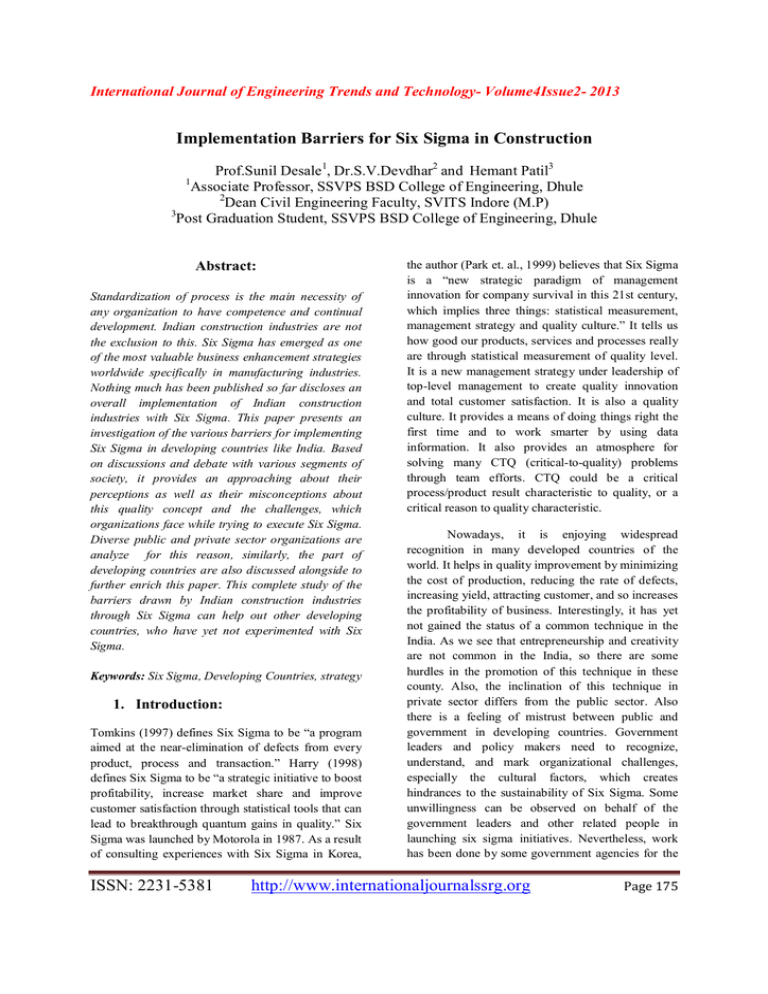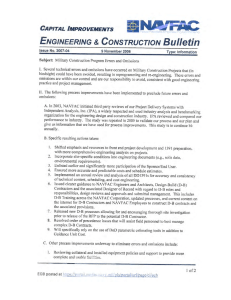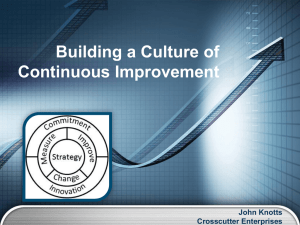Implementation Barriers for Six Sigma in Construction
advertisement

International Journal of Engineering Trends and Technology- Volume4Issue2- 2013 Implementation Barriers for Six Sigma in Construction Prof.Sunil Desale1, Dr.S.V.Devdhar2 and Hemant Patil3 1 Associate Professor, SSVPS BSD College of Engineering, Dhule 2 Dean Civil Engineering Faculty, SVITS Indore (M.P) 3 Post Graduation Student, SSVPS BSD College of Engineering, Dhule Abstract: Standardization of process is the main necessity of any organization to have competence and continual development. Indian construction industries are not the exclusion to this. Six Sigma has emerged as one of the most valuable business enhancement strategies worldwide specifically in manufacturing industries. Nothing much has been published so far discloses an overall implementation of Indian construction industries with Six Sigma. This paper presents an investigation of the various barriers for implementing Six Sigma in developing countries like India. Based on discussions and debate with various segments of society, it provides an approaching about their perceptions as well as their misconceptions about this quality concept and the challenges, which organizations face while trying to execute Six Sigma. Diverse public and private sector organizations are analyze for this reason, similarly, the part of developing countries are also discussed alongside to further enrich this paper. This complete study of the barriers drawn by Indian construction industries through Six Sigma can help out other developing countries, who have yet not experimented with Six Sigma. Keywords: Six Sigma, Developing Countries, strategy 1. Introduction: Tomkins (1997) defines Six Sigma to be “a program aimed at the near-elimination of defects from every product, process and transaction.” Harry (1998) defines Six Sigma to be “a strategic initiative to boost profitability, increase market share and improve customer satisfaction through statistical tools that can lead to breakthrough quantum gains in quality.” Six Sigma was launched by Motorola in 1987. As a result of consulting experiences with Six Sigma in Korea, ISSN: 2231-5381 the author (Park et. al., 1999) believes that Six Sigma is a “new strategic paradigm of management innovation for company survival in this 21st century, which implies three things: statistical measurement, management strategy and quality culture.” It tells us how good our products, services and processes really are through statistical measurement of quality level. It is a new management strategy under leadership of top-level management to create quality innovation and total customer satisfaction. It is also a quality culture. It provides a means of doing things right the first time and to work smarter by using data information. It also provides an atmosphere for solving many CTQ (critical-to-quality) problems through team efforts. CTQ could be a critical process/product result characteristic to quality, or a critical reason to quality characteristic. Nowadays, it is enjoying widespread recognition in many developed countries of the world. It helps in quality improvement by minimizing the cost of production, reducing the rate of defects, increasing yield, attracting customer, and so increases the profitability of business. Interestingly, it has yet not gained the status of a common technique in the India. As we see that entrepreneurship and creativity are not common in the India, so there are some hurdles in the promotion of this technique in these county. Also, the inclination of this technique in private sector differs from the public sector. Also there is a feeling of mistrust between public and government in developing countries. Government leaders and policy makers need to recognize, understand, and mark organizational challenges, especially the cultural factors, which creates hindrances to the sustainability of Six Sigma. Some unwillingness can be observed on behalf of the government leaders and other related people in launching six sigma initiatives. Nevertheless, work has been done by some government agencies for the http://www.internationaljournalssrg.org Page 175 International Journal of Engineering Trends and Technology- Volume4Issue2- 2013 promotion of Six Sigma and some companies have seen tremendous success, while others have abandoned this approach or found it too hard, because in Six Sigma, decisions are required to be based on data and statistics, not just on assumptions and anecdotal evidence. It starts from determining the need for a project, determining the cause of the problems being solved and then deciding what improvements it will make. In all these processes, data is required for decision making. This cumbersome work of data collection discourages the organizational heads to invest time and other resources in this newly developed concept of quality, which is used by Motorola and other large companies to successfully achieve positive changes in their organizations. The results of Six Sigma have the potential to benefit customers, employees, and shareholders. In order to effectively use the Six Sigma methodology, a substantial amount of time and resources must be allowed for a project. 2. Barriers to Implement Lean Six Sigma: Changing an organization in developing countries from old habits into new working system is difficult. Many organizations in developing countries have failed attempts in lean transformation due to a variety of reasons. These reasons can be identified as barriers and roadblocks which may halt the conversion process into lean; therefore it is essential to address barriers that impede the developing countries organization to adopt lean philosophy. Barriers to lean implementation vary from a firm to another one based on aims and objectives, and firm types. Swamidess (2000) has grouped theses barriers into four categories only. a) Technological barriers: Technologies innovations have most impacts on the varying process. For example new construction machinery, network, and activities planning technologies are fundamental factors within production and information generated systems. Technology includes production design and scheduling, and quality and operation measurements. Updated technologies help organizations to close the gap from the current state to future (desired) state. On ISSN: 2231-5381 the other hand traditional and old technologies can impede lean implementation process. Most of developing countries do not change their traditional technique with latest technique. The majority of Construction Companies in India perform a work by labor. b) Financial barriers: Achanga et al (2006) have emphasized the vital role of the financial capacity within the process of lean implementation. The application of lean philosophy requires financial resources to cover the implementation expenses such as hiring change agent, and training the people. Most construction organizations in India with limited financial resources may view the changing process as unnecessary loss of resources. Lean manufacturing aims to develop integrated improvement strategy in order to achieve the top level organization aims and objectives. For example lean implementation results in a reduction of waste and inventories aiming to increase the materials flow through the system; in contrast developing countries are having traditional accounting views inventories reduction as reduction in the income. The traditional financial measures emphasize on sub-optimization strategy which aims at improving a certain part or activity of the value stream in isolation of the whole system. The traditional financial measurements are inadequate because of: a) They do not recognize the necessitate of a comprehensive integrated strategy to improve the whole system instead of controlling and improving a certain areas or activities in isolation, and b) They provide unrealistic historical information and data (Maskell et al, 2007, Bititci, 2004). c) External barriers: Numerous external factors can influence and impede any lean transforming process. For example Hallgren et al (2009) and Devan (2004) have mentioned that the absence or insufficient of integrated communication and cooperation between the firms and their suppliers can prevent the changing process. According to Comm et al, (2000) misunderstanding http://www.internationaljournalssrg.org Page 176 International Journal of Engineering Trends and Technology- Volume4Issue2- 2013 of customer value is counted as a main factor which may prevent lean implementation process. Tax laws, competitive instant, trade agreements, and political and economical environments have direct influences on the transmutation process. For example the recent global economic recession situation causes sharp downturn in market demands which has a negative impact on any improvement process (Murray, 2009). Most of policy about Indian construction industry discourage the contractor such as land acquisition act and recently oppose to toll road project through various political leaders. When the organizations want to adopt some new technology on site, there will be some discontent behaviors and resistances from technical members. Experienced construction professional mentioned that when the cost & revenue comparison and quality do not meet against the expectations, there should be unwillingness for adoption of new technique from top management level. However, most construction professional believed that construction industry is quite traditional for new technologies and management mentality. ii) d) Internal barriers: Narang (2008) and Brown et al (2006) have emphasized that the lean is not just a tool kit which is used to reduce the costs and inventories, or about removing wastes and enhancing productivity. Nevertheless Lean is about human resources, leadership, management, and culture. Achanga et al (2006) have mentioned the vital role of the commitments of managers and leaders in determining the success of lean implementation. An absence of strong supportive leadership to lean transformation will halt and block any transforming process. The beneficial lean journey starts with fully understanding of the lean principles and tools, and identifying the right technique for a specific sequence. Any misconception of lean concepts will result in failure of lean implementation. The internal barriers can be divided into three main factors such as: i) Human factor: The human natural tends to resist change; people resist the change and they are more comfortable with the existing working manner. A negative feeling may be developed when the lean is introduced within the organization because of communication lack, and misconceive the real purpose of lean. Any noncooperative and unsupportive attitude can easily obstruct the lean implementation (Kessler 2006, and Baker 2002). Human-related factors in construction industry are very vital in order to realize new concepts and innovation. That’s why; study emphasized the importance of human-related resistance factors to Six Sigma. ISSN: 2231-5381 Culture factor: The culture can be defined as the behaviors, attitudes, and beliefs that exist within the organization. The simplest description of the culture is the combination of processes, systems, symbols, and ritual that are adopted in order to achieve the organization objectives and missions. The organizational culture is reflected in the structure way, how information is communicated, and the set up of hierarchal levels of the organization (Longman et al, 2004). Based on works of Sim et al, (2009), Rashid et al, (2004), and Derek (2000) organizational culture is the most challengeable roadblock to lean implementation. Wilson (2001) has declared that the organizational culture is not monolithic because of the various subcultures existence which is accounted as a main source of conflict within the firm. The sub-culture can be existed as result of variation in individual skills and education, and departmental objectives and values. Organizations differ in their resistance and response to change based on some factors such as: degree of readiness to change within the organization, leadership type, motivation and communication systems, individual knowledge and skill levels, and self-esteem and perspective. iii) Learning factor: It has been mentioned that each lean implementation project is unique because organizations vary in terms of their aims, objectives, capabilities and skills, policies, culture, problems, and constraints. Lean transformation may fail, when a firm attempts to copy a lean project which has been implemented successfully by a competitor. In most of construction http://www.internationaljournalssrg.org Page 177 International Journal of Engineering Trends and Technology- Volume4Issue2- 2013 industry there is not research and development department so the learning barrier is formed when the developing organization cannot recognize that the lean implementation process is a continuous learning process rather than kit of tools and techniques. iv) Absence of customer voice compotation: and No customer pressure drives or enforces the construction industry especially in real estate to initiate any improvement process. For example most of the flat quality before selling to customer is not check by any government agency in market. Furthermore absence or low competition levels because of high market restrictions. This leads to misconception of no need to implement any kind of improvement strategies. v) Providing the right training and education programs: Good and appropriate training and education programs should be provided in order to build multifunctional teams, and handle the miss-concepts and encourage the people to participate in the changing and decision making processes. 3. Outcomes/Conclusion: It is theoretically study was discussing the implementation barriers of six sigma in construction industry, worldwide especially in developing countries like India. All critical factors for effectively implementation of six sigma in construction is extracted in study and it useful for developing countries construction organization for, minimization waste, variation in process, satisfied customer requirement and complete a project within stipulated time and duration. Through this organization achieve its financial goal. According to the study, it was initiated that factors such as leadership and top level management involvement, develop a six sigma programmed as per organization culture, supporting organizational infrastructures, and training and ISSN: 2231-5381 understanding Six Sigma concepts to employee are the most important factors, this are essential factors for implementing six sigma programme in organization. However, a few constraints and limitations might exist in each of the theoretically base studies, such as the sample of companies, available data and analysis method, time constraints, etc. It observed that some of available data gathered through email and postal survey due to less financial budget so it will raise a question on authenticity of information. Most of organization doesn’t have any problem for funding of six sigma training but implementation of theoretically knowledge in practically is major problem in front of all organization. After implementation of six sigma philosophy in organization management don’t have exact performance measurement technique for compute the improvement in process. References: [1] Darshak A. Desai and Mulchand B. Patel: Impact of Six Sigma in a Developing economy: Analysis on benefits drawn by Indian industries, JIEM, 2009-2(3): 517-538, ISSN: 20130953 [2] Ali Rizwan, PhD, University of Engg. And Technology Taxila, Pakistan: Six Sigma and Developing Countries. [3] Hemant Patil and Prof.Sunil Desale: Lean Six Sigma In Construction: A Literature Review, (IJCIET), ISSN 0976 – 6308 (Print), Volume 3, Issue 2, July- December (2012), pp. 369-372 [4] Sung H. Park, Six Sigma for Quality and Productive Promotion, Published by the Asian Productivity Organization, 2003, ISBN: 92-833-1722-X, 1-2p. [5] Taher Tourki: Implementation of lean within the cement industry, a thesis submitted in De Montfort University for the Degree of Doctor of Philosophy, Dec.2010 [6] Muharrem Firat Yilmaz: Six Sigma within Construction Context As a Quality Initiative, Performance Indicator /Improver, Management Strategy, KTH Architecture and built environment [7] Arash Shahin; Department of Management, University of Isfahan; Isfahan, Iran: A Comprehensive Framework for Six Sigma Critical Success Factors with an Experience in a Developing Country; Quality management and six sigma ISBN 978-953-307-130-5 http://www.internationaljournalssrg.org Page 178






